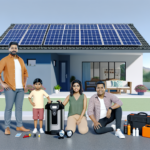Introduction to Solar Products for Eco-Conscious Adventurers
The Importance of Solar Energy in Outdoor Adventures
In recent years, the push towards sustainable living has gained significant momentum, and solar energy has emerged as a leading solution for reducing our dependence on traditional power sources. For eco-conscious adventurers, the importance of solar energy cannot be overstated. Whether you’re hiking, camping, or embarking on a long-term expedition, having a reliable and renewable energy source is crucial. Solar products allow adventurers to power their devices, stay connected, and maintain essential equipment without relying on fossil fuels or disposable batteries. This not only minimizes environmental impact but also enhances the overall outdoor experience by providing a sense of independence and self-sufficiency.
Benefits of Using Solar Products
The benefits of using solar products for outdoor adventures are numerous and compelling:
- Environmental Impact: Solar energy is a clean and renewable resource that significantly reduces carbon footprints and greenhouse gas emissions.
- Cost-Effective: After the initial investment, solar products provide free energy, reducing the need for costly disposable batteries or fuel.
- Reliability: Solar products offer a dependable power source in remote locations where traditional power sources are unavailable.
- Portability: Modern solar products are designed to be lightweight and compact, making them easy to carry on any adventure.
- Versatility: From charging small devices like smartphones and GPS units to powering larger equipment like lights and portable refrigerators, solar products cater to a wide range of needs.
Overview of the Article
This comprehensive guide aims to equip eco-conscious adventurers with the knowledge needed to choose the best solar products for their outdoor activities. The article is structured as follows:
- Understanding Different Types of Solar Products: We will explore various solar products, including solar panels, solar chargers, solar-powered gadgets, and solar generators.
- Key Factors to Consider When Choosing Solar Products: This section will cover essential considerations such as energy needs assessment, portability, durability, efficiency, and ease of use.
- How to Evaluate Solar Product Specifications: Learn how to interpret wattage, voltage, battery capacity, conversion efficiency, and compatibility with other devices.
- Practical Tips for Using Solar Products in the Outdoors: Discover best practices for optimal placement, maximizing sunlight exposure, maintaining equipment, and troubleshooting common issues.
- Sustainable Practices and Ethical Considerations: Understand the importance of eco-friendly manufacturing, ethical sourcing, recycling, and supporting companies with strong ethical values.
- Conclusion and Final Recommendations: A summary of key points, final tips for making informed decisions, and encouragement to embrace solar solutions.
By the end of this guide, you will be well-equipped to make informed decisions about incorporating solar products into your outdoor adventures, ensuring a more sustainable and enjoyable experience.
Understanding Different Types of Solar Products
Solar Panels
Solar panels are the cornerstone of any solar-powered setup, converting sunlight into electricity through photovoltaic cells. These panels come in various forms, including rigid, flexible, and foldable designs, each suited for different applications. **Rigid solar panels** are typically more efficient and durable, making them ideal for permanent installations on RVs or camper roofs. **Flexible solar panels** offer versatility, as they can conform to curved surfaces, making them suitable for unconventional setups. **Foldable solar panels** provide a middle ground, combining portability with decent power output, perfect for those who need a balance between efficiency and ease of transport.
Solar Chargers
Solar chargers are compact devices designed to charge small electronics like smartphones, tablets, and cameras. They are particularly useful for hikers, campers, and anyone on the move. These chargers often come with built-in batteries, allowing you to store energy for later use. **Portable solar chargers** can be as small as a smartphone, making them easy to carry in a backpack. **Solar power banks** are another popular option, combining a solar panel with a battery pack to provide a reliable power source even when the sun isn’t shining.
Solar-Powered Gadgets
The market for solar-powered gadgets has expanded significantly, offering a range of products that cater to various needs. **Solar lanterns and lights** are essential for camping trips, providing illumination without the need for batteries or fuel. **Solar-powered cookers** allow you to prepare meals using only sunlight, making them an eco-friendly alternative to traditional stoves. **Solar water purifiers** are another innovative product, using UV light to kill bacteria and viruses, ensuring safe drinking water in remote locations. These gadgets not only enhance your outdoor experience but also reduce your environmental footprint.
Solar Generators
Solar generators are comprehensive power solutions that combine solar panels, batteries, and inverters into a single unit. They are designed to provide a reliable power source for larger applications, such as running appliances, charging multiple devices, and even powering small homes or RVs. **Portable solar generators** are ideal for off-grid adventures, offering a compact and lightweight solution for those who need substantial power on the go. **Stationary solar generators** are more robust and can be used as backup power sources for homes or cabins. These generators are an excellent investment for anyone looking to embrace a sustainable lifestyle while ensuring they have access to reliable power.
In summary, understanding the different types of solar products available can help you make informed decisions based on your specific needs and lifestyle. Whether you’re a casual camper or a dedicated off-grid enthusiast, there’s a solar solution out there to enhance your eco-conscious adventures.
Key Factors to Consider When Choosing Solar Products
Energy Needs Assessment
Understanding your energy requirements is the first step in selecting the right solar products. Begin by listing all the devices and appliances you plan to power. Calculate their total energy consumption, typically measured in watt-hours (Wh). For instance, if you need to charge a smartphone (5-20W), a laptop (30-90W), and run a small refrigerator (50-100W), you’ll need a solar solution that can handle this combined load. This assessment helps you determine the necessary power output and storage capacity of your solar products.
Portability and Weight
For eco-conscious adventurers, portability is crucial. Solar products should be lightweight and easy to transport. Look for foldable solar panels and compact solar chargers that can fit into your backpack or vehicle without adding significant bulk. The most portable options often come with integrated carrying handles and are designed to be set up quickly, making them ideal for camping, hiking, and other outdoor activities.
Durability and Weather Resistance
Durability is essential, especially for products used in outdoor environments. Choose solar products made from robust materials that can withstand various weather conditions, including rain, wind, and extreme temperatures. Look for features like waterproofing (IP67 rating or higher), scratch-resistant coatings, and reinforced edges. These attributes ensure that your solar equipment remains functional and reliable, even in harsh conditions.
Efficiency and Output
Efficiency refers to how well a solar panel converts sunlight into usable electricity. Higher efficiency panels (20% and above) generate more power from the same amount of sunlight, which is particularly beneficial in low-light conditions. When evaluating efficiency, also consider the output capacity. Solar panels and chargers come in various wattages, so choose one that matches your energy needs. For example, a 100W panel is suitable for charging small devices, while a 200W panel can power larger appliances like mini-fridges.
Ease of Use and Maintenance
Ease of use and maintenance are important for hassle-free operation. Opt for solar products that are user-friendly, with straightforward setup instructions and minimal maintenance requirements. Features like built-in USB ports, adjustable angles for optimal sunlight capture, and clear indicator lights for battery status can enhance usability. Regular maintenance, such as cleaning the panels and checking for damage, ensures long-term efficiency and performance. Choose products that come with comprehensive user manuals and customer support to assist with any issues.
By considering these key factors, you can select solar products that not only meet your energy needs but also align with your lifestyle and environmental values.
How to Evaluate Solar Product Specifications
When choosing solar products for your outdoor adventures, understanding the technical specifications is crucial. This section will guide you through the key aspects to consider: wattage and voltage, battery capacity and storage, conversion efficiency, and compatibility with other devices.
Understanding Wattage and Voltage
**Wattage** and **voltage** are fundamental metrics in evaluating solar products.
– **Wattage** measures the power output of a solar panel or device. It indicates how much energy the product can generate or consume. For instance, a 100-watt solar panel can produce 100 watts of power per hour under optimal conditions.
– **Voltage** refers to the electrical potential difference. It’s essential to match the voltage of your solar panel with the devices you intend to power. Most portable solar panels for outdoor use come in 12V or 24V configurations.
Understanding these metrics helps ensure that your solar setup can meet your energy needs efficiently. For example, if you plan to charge a 12V battery, using a 12V solar panel is ideal to avoid compatibility issues.
Battery Capacity and Storage
**Battery capacity** is another critical factor, especially if you plan to store solar energy for use when sunlight is unavailable.
– **Capacity** is measured in ampere-hours (Ah) or watt-hours (Wh). A higher capacity means the battery can store more energy. For example, a 100Ah battery at 12V can store 1200Wh of energy.
– **Storage** solutions vary from small portable batteries to larger solar generators. Consider your energy consumption patterns to choose the right capacity. If you need to power multiple devices overnight, a higher capacity battery is necessary.
Additionally, look for batteries with built-in management systems that protect against overcharging and deep discharging, which can prolong the battery’s lifespan.
Conversion Efficiency
**Conversion efficiency** indicates how effectively a solar panel converts sunlight into usable electricity.
– **Efficiency rates** typically range from 15% to 22%. Higher efficiency panels generate more power in a smaller footprint, which is beneficial for portable applications where space is limited.
– **Types of panels**: Monocrystalline panels generally offer higher efficiency compared to polycrystalline and thin-film panels. However, they may come at a higher cost.
When evaluating efficiency, consider the trade-offs between cost, space, and power needs. Higher efficiency panels are ideal for maximizing energy production in limited spaces.
Compatibility with Other Devices
Ensuring **compatibility** with your existing devices is essential for a seamless solar experience.
– **Output ports**: Check the types and number of output ports available on the solar product. Common ports include USB, DC, and AC outlets. Ensure the solar charger or generator has the appropriate ports for your devices.
– **Voltage and current ratings**: Match the voltage and current ratings of the solar product with your devices to avoid damage. For instance, charging a 5V USB device with a 12V output can cause harm.
– **Adapters and cables**: Some solar products come with multiple adapters and cables to enhance compatibility. Verify that these accessories are included or available for purchase.
By understanding these specifications, you can make informed decisions and select solar products that best meet your needs, ensuring a reliable and efficient power source for your eco-conscious adventures.
Practical Tips for Using Solar Products in the Outdoors
Optimal Placement and Angle for Solar Panels
To maximize the efficiency of your solar panels, it’s crucial to place them in an optimal location and at the correct angle. **Position your panels in a spot that receives the most direct sunlight throughout the day.** In the northern hemisphere, this typically means facing them south, while in the southern hemisphere, they should face north.
**Adjust the tilt of your panels** to match the latitude of your location. For instance, if you’re at a latitude of 30 degrees, tilt your panels at a 30-degree angle. This helps in capturing the maximum amount of solar energy. During different seasons, you might need to adjust the tilt slightly to account for the sun’s changing position in the sky.
Maximizing Sunlight Exposure
**Maximizing sunlight exposure** is key to harnessing the full potential of your solar products. Here are some tips to ensure your panels get the most sunlight:
1. **Avoid Shaded Areas:** Place your solar panels away from trees, buildings, or other structures that could cast shadows.
2. **Track the Sun:** If possible, reposition your panels throughout the day to follow the sun’s path. This can significantly increase the amount of energy captured.
3. **Use Solar Trackers:** For those who want to automate the process, solar trackers can adjust the panel’s position to follow the sun, ensuring optimal exposure.
Maintaining and Cleaning Solar Equipment
Regular maintenance and cleaning are essential to keep your solar equipment functioning efficiently. **Dust, dirt, and debris can accumulate on the surface of solar panels, reducing their efficiency.** Here are some maintenance tips:
1. **Routine Cleaning:** Use a soft cloth or sponge with mild soapy water to clean the surface of your panels. Avoid abrasive materials that could scratch the surface.
2. **Inspect for Damage:** Regularly check for any signs of wear and tear, such as cracks or scratches, and address them promptly.
3. **Check Connections:** Ensure all electrical connections are secure and free from corrosion. Loose or corroded connections can lead to inefficiencies or even hazards.
Troubleshooting Common Issues
Even with the best care, you might encounter some common issues with your solar products. Here are a few troubleshooting tips:
1. **Low Power Output:** If your solar panels are not generating enough power, check for obstructions blocking sunlight, clean the panels, and ensure they are positioned correctly.
2. **Battery Not Charging:** If your solar charger or generator isn’t charging the battery, inspect the connections and ensure the battery is still functional. Sometimes, a faulty charge controller could be the culprit.
3. **Inconsistent Performance:** Fluctuating power output can be due to partial shading or dirty panels. Ensure your panels are clean and fully exposed to sunlight.
By following these practical tips, you can ensure that your solar products perform optimally, providing you with reliable and sustainable energy during your outdoor adventures.
Sustainable Practices and Ethical Considerations
Eco-Friendly Manufacturing Processes
Eco-conscious adventurers should prioritize solar products manufactured through environmentally friendly processes. This includes using renewable energy sources in production, minimizing waste, and reducing carbon emissions. Companies that adopt green manufacturing practices often use recycled materials and implement energy-efficient technologies. For instance, some manufacturers use solar energy to power their factories, further reducing their carbon footprint. By choosing products from such companies, you support a cycle of sustainability that extends beyond the product’s use.
Ethical Sourcing of Materials
The materials used in solar products should be sourced ethically to ensure minimal environmental impact and fair labor practices. Ethical sourcing involves obtaining raw materials in a way that respects human rights and the environment. This includes avoiding conflict minerals, ensuring fair wages, and maintaining safe working conditions. Look for certifications such as Fair Trade or those from organizations like the Responsible Minerals Initiative. By supporting companies that prioritize ethical sourcing, you contribute to a more equitable and sustainable global supply chain.
Recycling and Disposal of Solar Products
Proper recycling and disposal of solar products are crucial for minimizing environmental impact. Solar panels, batteries, and other components contain materials that can be harmful if not disposed of correctly. Many manufacturers offer take-back programs or recycling services to ensure that their products are disposed of responsibly. When purchasing solar products, inquire about the company’s recycling policies and choose those that provide clear guidelines and support for end-of-life disposal. This not only helps reduce waste but also promotes the reuse of valuable materials.
Supporting Companies with Strong Ethical Values
Choosing to support companies with strong ethical values is a powerful way to promote sustainability. These companies often go beyond eco-friendly manufacturing and ethical sourcing; they also engage in community development, environmental conservation, and transparent business practices. Research and select brands that are committed to sustainability and ethical practices. Look for companies that publish sustainability reports, participate in environmental initiatives, and have certifications from reputable organizations. By supporting these companies, you help drive the market towards more responsible and sustainable practices.
In conclusion, eco-conscious adventurers can make a significant impact by choosing solar products that are manufactured sustainably, sourced ethically, and disposed of responsibly. Supporting companies with strong ethical values further amplifies this impact, contributing to a healthier planet and a more equitable society.
Conclusion and Final Recommendations
Summary of Key Points
In this guide, we have explored the essential aspects of choosing solar products for eco-conscious adventurers. We began by understanding the importance of solar energy in outdoor adventures and the numerous benefits it offers, such as sustainability, independence from traditional power sources, and cost savings. We then delved into the different types of solar products available, including solar panels, solar chargers, solar-powered gadgets, and solar generators. Key factors to consider when selecting solar products were discussed, such as energy needs assessment, portability, durability, efficiency, and ease of use. Additionally, we covered how to evaluate solar product specifications, practical tips for using solar products outdoors, and sustainable practices and ethical considerations.
Final Tips for Making an Informed Decision
When choosing solar products for your outdoor adventures, keep the following tips in mind to make an informed decision:
- Assess Your Energy Needs: Calculate your daily energy consumption and choose products that can meet or exceed these requirements.
- Prioritize Portability: Opt for lightweight and compact solar products that are easy to transport and set up.
- Check Durability: Ensure the products are built to withstand harsh outdoor conditions, including water resistance and rugged construction.
- Evaluate Efficiency: Look for high-efficiency solar panels and devices to maximize energy capture and usage.
- Consider Compatibility: Ensure the solar products are compatible with your existing devices and power systems.
- Read Reviews and Ratings: Research and read user reviews to gauge the reliability and performance of the products.
- Support Ethical Companies: Choose products from companies that prioritize eco-friendly manufacturing processes and ethical sourcing of materials.
Encouragement to Embrace Solar Solutions
Embracing solar solutions for your outdoor adventures is not only a step towards sustainability but also a way to enhance your overall experience. By harnessing the power of the sun, you can enjoy the freedom of off-grid living, reduce your environmental footprint, and contribute to a cleaner, greener planet. Solar products offer a reliable and renewable energy source, allowing you to stay connected, powered up, and comfortable during your adventures.
As you embark on your journey to choose the right solar products, remember that every small step towards using renewable energy makes a significant impact. Whether you are a seasoned adventurer or a novice explorer, integrating solar solutions into your outdoor activities is a rewarding and responsible choice. So, take the plunge, invest in quality solar products, and enjoy the benefits of sustainable and eco-friendly adventures. The sun is a powerful ally—embrace its energy and let it illuminate your path to a greener future.






